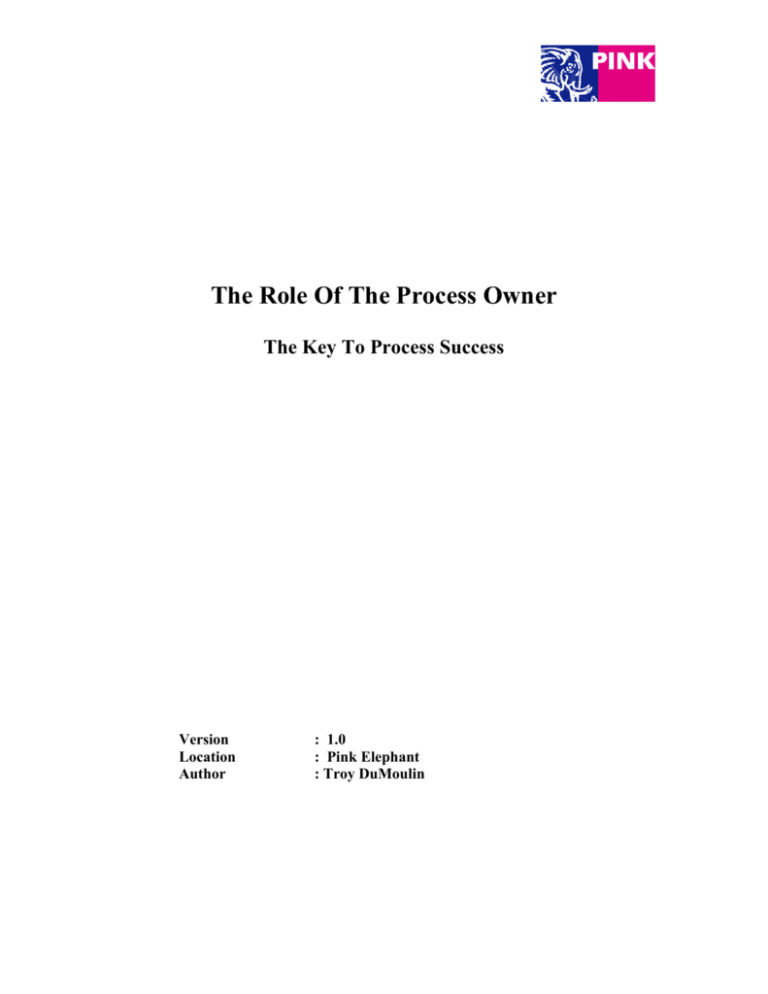
The Role Of The Process Owner
The Key To Process Success
Version
Location
Author
: 1.0
: Pink Elephant
: Troy DuMoulin
The Role Of The Process Owner – The Key To Process Success
Table Of Contents
1
EXECUTIVE SUMMARY ........................................................................................ 3
2
THE ROLE OF THE PROCESS OWNER ................................................................ 4
3
PROCESS OWNERSHIP COMBINATIONS ........................................................... 6
4
SUMMARY ................................................................................................................ 8
©Pink Elephant 2008 unless otherwise stated. All Right Reserved.
Page 2 of 8
The Role Of The Process Owner – The Key To Process Success
1
EXECUTIVE SUMMARY
Since the advent of Henry Ford’s Model T and the creation of complex assembly lines,
organizational designs have focused on breaking apart complex processes into individual
tasks – the result of which manifests itself as silo or stove pipe based organizational
charts where the right hand has little knowledge of what the left hand is doing.
As technically focused IT shops transition into service organizations, we have to splice
back together what has been artificially separated. In reality, what is occurring when an
organization defines IT services and processes, is that two new virtual horizontal
organizational structures are being established on top of the traditional domain-based
silos. The end result of this is the establishment of a matrix organization where
individuals within now have multiple lines of accountability and are constantly faced
with the requirement to prioritize their time.
Without a doubt, a critical role to process implementation is the creation and
empowerment of a single, accountable process owner whose management activities and
scope of governance span across the great divide between organizational silos.
The process owner plays the important role of champion, visionary, protector and
advocate – without whom the process has absolutely no chance of survival.
©Pink Elephant 2008 unless otherwise stated. All Right Reserved.
Page 3 of 8
The Role Of The Process Owner – The Key To Process Success
2
THE ROLE OF THE PROCESS OWNER
The initial planning phase of any ITIL® project must include establishing the role of
Process Owner. This key role is accountable for the overall quality of the process and
oversees the management of, and organizational compliance to, the process flows,
procedures, data models, policies, and technologies associated with the IT business
process.
The Process Owner performs the essential role of Process Champion, Design Lead,
Advocate, Coach and Protector. Typically, a process owner should be a senior level
manager with credibility, influence and authority across the various areas impacted by the
activities of the process. The Process Owner is required to have the ability to influence
and assure compliance to the policies and procedures put in place across the cultural and
departmental silos of the IT organization.
A Process Owner’s job is not necessarily to do the hands-on process re-engineering and
process improvement, but to ensure that it gets done. He or she typically assembles the
project team, obtains the resources that the team requires, protects the team from internal
politics, and works to gain cooperation of the other executives and managers whose
functional groups are involved in the process. This role’s responsibilities do not end with
the successful embedding of a new process. In a process-oriented organization, the
Process Owner remains responsible for the integrity, communication, functionality,
performance, compliance and business relevance of the process.
2.1
Process Owner Job Description
The major activities of the Process Owner are Process Design, Organizational Awareness,
and Advocacy.
Process Design
Accountable for the ongoing business value and integrity of the process design
across the functional and organizational boundaries the process crosses:
Process and procedures
Policies
Process roles
Key performance indicators (KPIs)
Process automation requirements
Process integrations
©Pink Elephant 2008 unless otherwise stated. All Right Reserved.
Page 4 of 8
The Role Of The Process Owner – The Key To Process Success
Organizational Awareness
Accountable for planning and implementing practices, orientation and training to
ensure organizational understanding and adoption of the process activities:
Internal and external training
New employee on-boarding and orientation
One-on-one mentoring
Teambuilding exercises
Conflict facilitation
Communication and feedback forums
Advocacy
Accountable for protecting, measuring and reporting on process compliance
across organizational silos:
Dealing with political issues in relationship to process compliance
Promoting a culture of process collaboration
Breaking down strong silo or functional mindsets
Verifying process compliance on an ongoing basis
Representing IT processes to business
Managing process exceptions
Promoting integration with other processes
Note: While design and organizational learning can be delegated to other process roles, it
is not advisable to ever delegate advocacy.
©Pink Elephant 2008 unless otherwise stated. All Right Reserved.
Page 5 of 8
The Role Of The Process Owner – The Key To Process Success
3
PROCESS OWNERSHIP COMBINATIONS
When reading the ITIL books, the reader can be led to assume that each process has a
unique Process Owner assigned; however, while it may be possible to do this in a large
organization, it is far more likely that a single individual may be required to oversee and
champion two or more ITIL processes. This concept of multiple processes itself is not an
issue, providing the person designated with these accountabilities has enough time to
manage the various processes effectively. Care must be taken in the selection of what
combinations work well and which represent a conflict of interest based on the process
objectives. The following list provides examples of both good and potentially challenging
combinations.
3.1
Difficult Combinations
Incident & Problem Management
At face value, these two processes look ideally suited for joint ownership. However, in
practice this is rarely the case. Unlike other processes, the challenge does not lie in an
inherent conflict of interest; rather, what is typical is that the goals of Problem
Management are subverted by the urgency of service restoration.
The Problem Management process is responsible for taking a holistic view of the issues
around service delivery by identifying systemic IT issues and service degradation trends.
Incident Management is primarily concerned with the restoration of service as quickly as
possible. The typical result of combining these processes is that Problem Management
activities are often overridden by the immediate need of fire fighting. This is even more
apparent when the Problem Management coordinators are given the role of managing the
major incident or crisis processes and resulting post-incident reviews. The great majority
of time is then spent in what is actually an Incident Management role and the proactive
side of Problem Management is largely neglected.
Change & Incident Or Problem Management
The objective of Change Management is to efficiently handle, assess, approve and
coordinate all changes to the IT infrastructure in an efficient manner. At the same time,
Incident and Problem Management are raising records that result in requests for changes.
To combine these process ownerships is to invite a conflict of interest around the required
due diligence for Change Management.
©Pink Elephant 2008 unless otherwise stated. All Right Reserved.
Page 6 of 8
The Role Of The Process Owner – The Key To Process Success
3.2
Strong Combinations
The following process combinations represent logical fits for process ownership.
Change & Configuration Management
Change Management acts as the primary control mechanism for the updating of the
Configuration Management Database (CMDB); likewise, Change Management relies on
configuration data for impact analysis. For this reason, the combination of the two
processes under a single accountability provides an added value to each process.
Change & Release Management
Both Change and Release Management deal with minimizing the impact of changes to
the IT infrastructure; this shared objective makes this pairing desirable.
Availability, Capacity & IT Service Continuity Management
Each of these processes is back-office related and deal with the right sizing of the IT
environment according to business needs. This combination is often under the control of
a tactical or strategic IT planning group.
Service Level Management & Financial Management For IT
Defining IT services, negotiating service levels and the cost associated with these
services makes SLM and Financial Management a possible fit; however, most
organizations will keep these separated, but aligned, due to the level of work required for
each activity.
©Pink Elephant 2008 unless otherwise stated. All Right Reserved.
Page 7 of 8
The Role Of The Process Owner – The Key To Process Success
4
SUMMARY
Best practices clearly indicate that process ownership should reside with a single
individual to ensure clear accountability. The Process Owner’s role is critical for the
successful design and ongoing management of the processes being implemented.
ITIL® is a Registered Trade Mark of the Office of Government Commerce in the United Kingdom and
other countries.
©Pink Elephant 2008 unless otherwise stated. All Right Reserved.
Page 8 of 8









